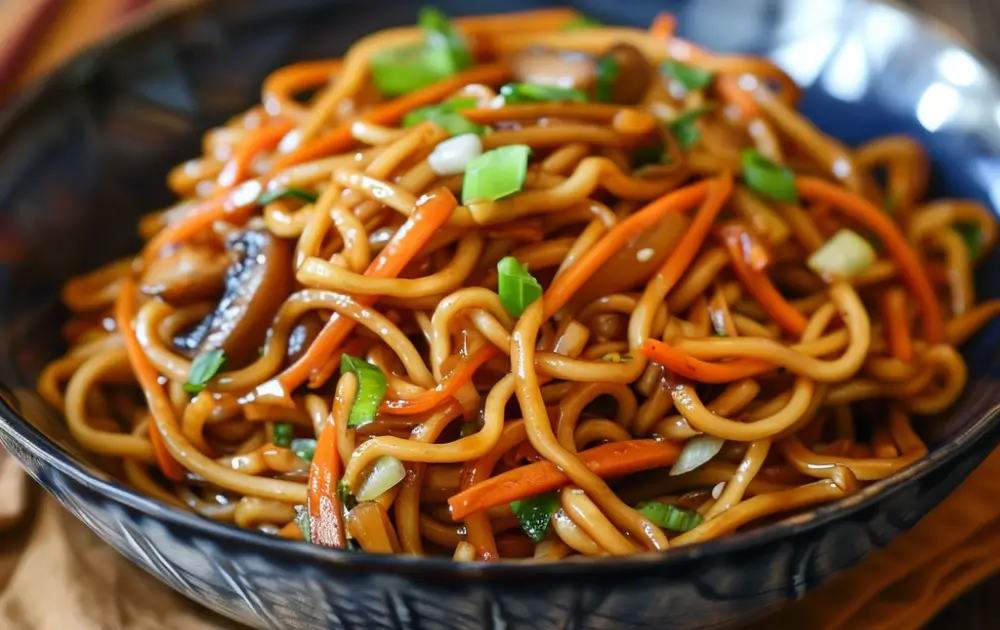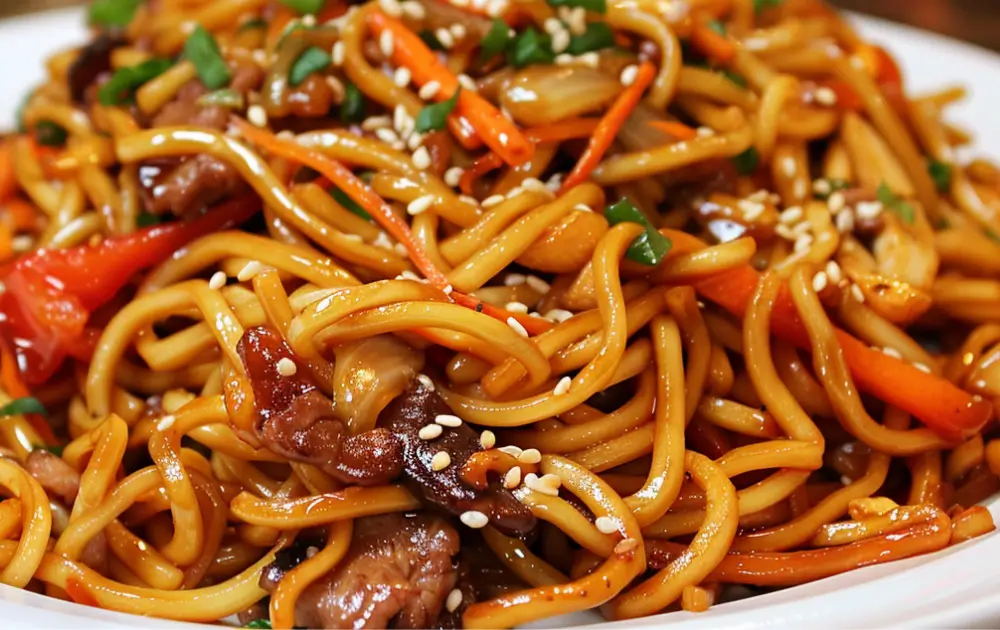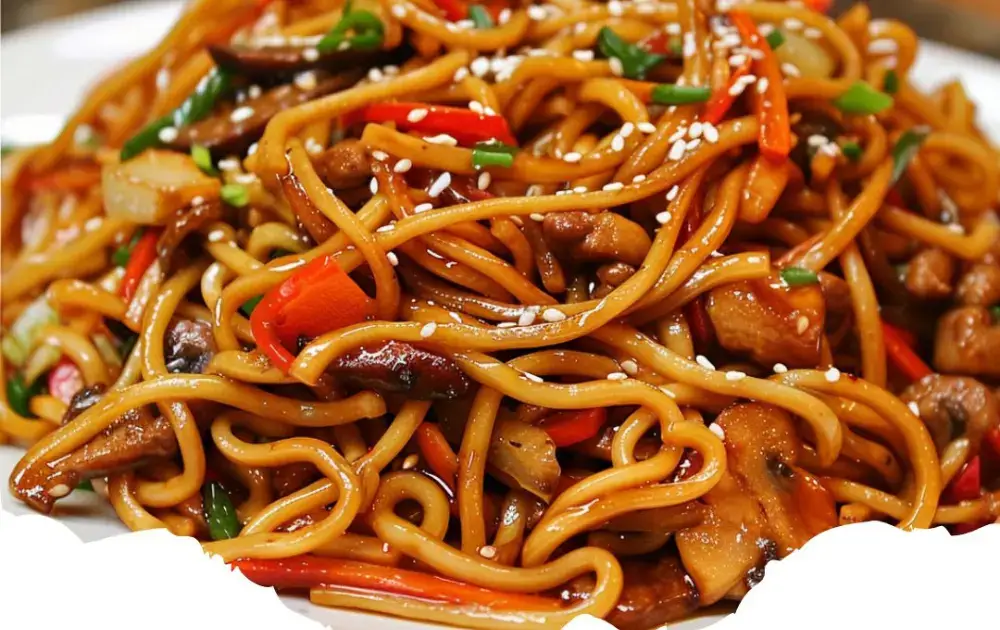Flavorful Lo Mein Recipe: Easy Chinese Noodle Dish
Exploring Lo Mein: A Delicious Chinese Dish
Lo Mein is a quintessential dish in Chinese cuisine, celebrated for its irresistible blend of savory flavors and comforting textures. Originating in the Guangdong province of southern China, this beloved noodle dish has a rich history dating back centuries. As Chinese immigrants brought their culinary traditions to the United States, Lo Mein underwent further adaptation and innovation, becoming a staple in Chinese-American cuisine. Today, it continues to captivate diners around the world with its versatile ingredients, vibrant colors, and aromatic sauces.
Origins in Chinese Cuisine:
- Lo Mein has its roots in Chinese cuisine, with a history dating back centuries.
- The dish originated in the Guangdong province of southern China, where it was traditionally made with wheat noodles stir-fried with vegetables and meat.
Early Development:
- Initially known as “lo mein” or “lao mian,” which translates to “stirred noodles” in Cantonese, the dish gained popularity in Chinese-American communities during the late 19th and early 20th centuries.
Evolution in America:
- Chinese immigrants brought their culinary traditions, including Lo Mein, to the United States, where it underwent further adaptation and innovation.
- American versions of Lo Mein often feature a wider variety of ingredients and sauces to suit local tastes.
Popularity and Influence:
- Lo Mein quickly became a staple in Chinese-American restaurants and gained popularity among American diners looking for flavorful and satisfying noodle dishes.
Cultural Significance:
- Today, Lo Mein holds a cherished place in both Chinese and American culinary cultures, symbolizing the fusion of flavors and culinary traditions from East and West.
Continued Appreciation:
- With its delicious flavors and versatile nature, Lo Mein continues to be enjoyed by people around the world, whether as a quick and comforting meal at home or a favorite menu item at Chinese restaurants.
Ingredients Used in Lo Mein: The key ingredients in Lo Mein typically include:
- Fresh noodles
- Assorted vegetables (such as carrots, bell peppers, and broccoli)
- Protein (such as chicken, beef, shrimp, or tofu)
- Garlic, ginger, soy sauce, and other seasonings
Preparation Steps:
- Cook the noodles according to package instructions until they are al dente.
- Stir-fry the protein and vegetables in a wok or skillet until they are cooked through but still crisp.
- Add the cooked noodles to the wok along with a sauce made from soy sauce, garlic, ginger, and other seasonings.
- Toss everything together until well combined and heated through.
Variations of Lo Mein: Lo Mein can be customized in various ways to suit different tastes and preferences. Some popular variations include:
- Vegetable Lo Mein: Made with a colorful assortment of fresh vegetables.
- Chicken Lo Mein: Featuring tender pieces of chicken cooked with vegetables and noodles.
- Shrimp Lo Mein: Incorporating succulent shrimp for a seafood twist.
- Tofu Lo Mein: A vegetarian option made with tofu cubes instead of meat.
Tips for Perfect Lo Mein:
- Use fresh noodles if possible, as they have a better texture and flavor than dried noodles.
- Cook the vegetables and protein quickly over high heat to retain their crispness and vibrant colors.
- Adjust the seasonings to taste, adding more soy sauce, garlic, or ginger as needed.
- Garnish the finished dish with sliced green onions or sesame seeds for added flavor and visual appeal.
Nutritional Benefits of Lo Mein: Lo Mein is a nutritious dish that provides a balance of carbohydrates, protein, and vegetables. It can be made with lean proteins and plenty of vegetables, making it a healthy option for a satisfying meal.
Enjoying Lo Mein: Whether enjoyed as a quick weeknight dinner or as part of a festive Chinese banquet, Lo Mein never fails to impress with its delicious flavors and satisfying textures. Experiment with different ingredients and variations to create your own unique twist on this classic Chinese dish.
Cooking Method:
Cooking the Noodles
- Boil a pot of water and cook the noodles according to package instructions until they are al dente.
- Drain the noodles and rinse them under cold water to stop the cooking process. Set aside.
Preparing the Ingredients
- Heat oil in a wok or large skillet over medium-high heat.
- Add chopped vegetables such as carrots, bell peppers, and broccoli, along with your choice of protein such as chicken, beef, shrimp, or tofu.
- Stir-fry the ingredients until they are cooked through and tender, but still crisp.
Making the Sauce
- In a small bowl, mix together soy sauce, minced garlic, grated ginger, and a pinch of sugar.
- Adjust the seasoning to taste, adding more soy sauce or sugar if desired.
Stir-Frying Everything Together
- Add the cooked noodles to the wok with the vegetables and protein.
- Pour the sauce over the noodles and toss everything together until well combined.
- Cook for an additional 2-3 minutes, allowing the flavors to meld and the noodles to heat through.
Serving and Enjoying
- Transfer the Lo Mein to serving plates or bowls.
- Garnish with sliced green onions or sesame seeds for added flavor and visual appeal.
- Serve hot and enjoy this delicious Chinese dish as a satisfying meal.
Cooking Tips:
- To prevent the noodles from sticking together, toss them with a little oil after cooking and rinsing.
- Use a high heat setting when stir-frying to achieve a nice sear on the vegetables and protein.
- Feel free to customize the Lo Mein with your favorite vegetables and protein choices for a personalized touch.
Nutritional Information:
- Lo Mein is a balanced meal that provides carbohydrates from the noodles, protein from the meat or tofu, and vitamins and minerals from the vegetables.
- By using lean proteins and plenty of vegetables, Lo Mein can be a healthy and nutritious option for a satisfying dinner.

Variations and Customization:
1. Vegetable Lo Mein:
- For a vegetarian option, skip the protein and load up on a colorful assortment of vegetables such as mushrooms, snap peas, and bok choy.
2. Seafood Lo Mein:
- Swap out the traditional protein for seafood such as shrimp, scallops, or squid for a delightful ocean-inspired twist.
3. Spicy Lo Mein:
- Add some heat to your Lo Mein by incorporating chili paste, crushed red pepper flakes, or sliced fresh chili peppers for a fiery kick.
4. Egg Lo Mein:
- Stir in beaten eggs during the cooking process to create luscious ribbons of egg throughout the dish, adding both flavor and texture.
Health Benefits:
1. Nutrient-Rich Ingredients:
- Lo Mein is packed with a variety of nutrient-rich ingredients such as vegetables, lean proteins, and whole-grain noodles, providing essential vitamins, minerals, and fiber.
2. Balanced Meal:
- With a balanced combination of carbohydrates, protein, and vegetables, Lo Mein offers a satisfying and nutritious meal option that can support overall health and well-being.
3. Customizable Portions:
- By adjusting the proportions of noodles, vegetables, and protein, you can easily customize Lo Mein to fit your dietary needs and preferences, whether you’re aiming for a lighter meal or a heartier feast.
4. Versatile Cooking Method:
- Lo Mein can be prepared using a variety of cooking methods, including stir-frying, boiling, or even steaming, allowing for flexibility in preparation and catering to different culinary preferences.
Cooking Techniques:
1. Stir-Frying Method:
- Stir-frying is the traditional cooking method for making Lo Mein, allowing for quick cooking and imparting a delicious smoky flavor to the dish.
2. Boiling Method:
- Alternatively, you can boil the noodles separately and then toss them with the stir-fried vegetables and protein along with the sauce for a simpler cooking approach.
3. Steaming Method:
- For a healthier twist, consider steaming the vegetables and protein before adding them to the noodles, preserving their nutrients and natural flavors.

Serving and Presentation:
1. Plating with Panache:
- Transfer the flavorful Lo Mein to serving plates or bowls, ensuring an attractive presentation.
- Garnish with a sprinkle of chopped green onions or a drizzle of sesame oil for a finishing touch.
2. Pairing Suggestions:
- Serve Lo Mein as a standalone dish for a satisfying meal, or pair it with other Chinese favorites such as egg rolls, pot stickers, or steamed dumplings for a complete feast.
3. Family-Friendly Fare:
- Lo Mein is a crowd-pleaser that appeals to all ages, making it perfect for family dinners, casual gatherings, or potluck parties.
4. Meal Prep Made Easy:
- Prepare a batch of Lo Mein ahead of time for convenient meal prep throughout the week. Simply store leftovers in an airtight container in the refrigerator and reheat as needed for quick and delicious meals on-the-go.
Cooking Secrets:
1. Flavor Infusion:
- Allow the noodles to soak up the flavors of the sauce by tossing them well with the stir-fried vegetables and protein, ensuring each bite is bursting with deliciousness.
2. Texture Harmony:
- Achieve the perfect balance of textures by stir-frying the vegetables until they are tender-crisp, adding a satisfying crunch to every mouthful of Lo Mein.
3. Sauce Sensation:
- Customize the sauce to your taste preferences by adjusting the ratio of soy sauce, garlic, ginger, and other seasonings, ensuring a harmonious blend of flavors that tantalize the taste buds.
4. Wok Mastery:
- Master the art of stir-frying in a hot wok to achieve that signature smoky flavor and irresistible aroma that sets Lo Mein apart from other noodle dishes.
Dietary Considerations:
- Lo Mein can be easily customized to suit various dietary preferences, including vegetarian, gluten-free, or low-carb diets, by selecting appropriate ingredients and substitutions.

Frequently Asked Questions (FAQs):
1. Can I use different types of noodles for Lo Mein?
- Yes, while traditional Lo Mein is made with wheat noodles, you can experiment with other varieties such as rice noodles or even whole wheat noodles for a healthier twist.
2. How can I make Lo Mein spicier?
- To add more heat to your Lo Mein, increase the amount of chili paste, chili flakes, or fresh chili peppers in the sauce, adjusting to your desired level of spiciness.
3. Can I make Lo Mein ahead of time?
- Yes, Lo Mein can be prepared in advance and reheated when ready to serve. Store leftovers in an airtight container in the refrigerator for up to 3-4 days.
4. Is Lo Mein gluten-free?
- Traditional Lo Mein made with wheat noodles contains gluten. However, you can make gluten-free Lo Mein by using rice noodles or gluten-free pasta as a substitute for wheat noodles.
Conclusion:
In conclusion, Lo Mein is a versatile and flavorful Chinese dish that offers endless possibilities for customization and creativity. With a few simple ingredients and cooking techniques, you can whip up a delicious and satisfying meal that will delight your taste buds. Whether you’re craving a quick weeknight dinner or planning a festive feast, Lo Mein is sure to impress with its irresistible combination of noodles, vegetables, and savory sauce. Explore the world of Lo Mein and unleash your culinary imagination!
Print
Lo Mein
- Total Time: 30 minutes
- Yield: 4 servings
Description
Lo Mein is a classic Chinese stir-fried noodle dish featuring wheat noodles tossed with vegetables, protein, and a savory sauce, creating a delicious and satisfying meal.
Ingredients
Instructions
Notes
– Customize the vegetables and protein to your preference.
– Adjust the amount of sauce and seasonings according to taste.
– Be mindful not to overcook the noodles to avoid mushiness.
- Prep Time: 15 minutes
- Cook Time: 15 minutes
- Category: Main dish
- Method: Stir-frying
- Cuisine: Chinese
Nutrition
- Calories: 350
- Fat: 10g
- Carbohydrates: 50g
- Fiber: 5g
- Protein: 15g

